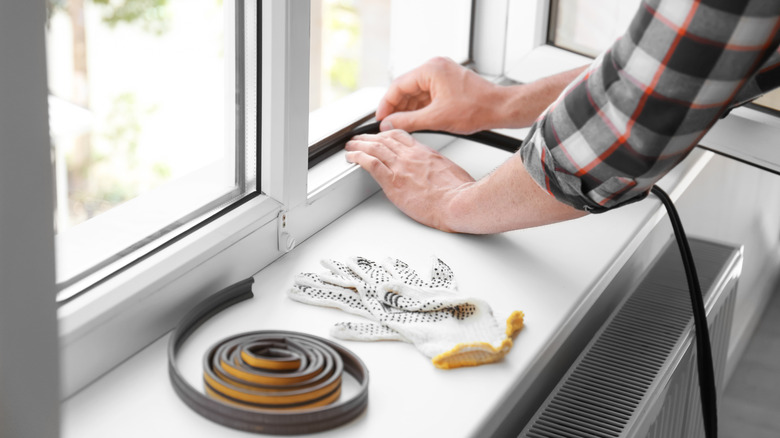Try An Affordable DIY Alternative To Window Kits For Winter Cold-Proofing
Insulating windows and doors for winter can not only make your home warmer and cozier, but it can also help reduce your energy bills by lessening the need to turn the heat on. Many older homes have drafty windows due to a variety of reasons, including age, need for better glazing or caulking, or shrinking or expansion of wood frames. Using plastic sheeting to cover windows can help reduce cold air drafts. While using commercial kits with shrink-to-fit plastic wrap is a common solution, they can be expensive, and you need a hand-held hair dryer to seal the plastic. To make this task more affordable, instead of choosing a window insulation kit, you can try a DIY approach to keeping your home warm and cozy.
To weatherproof your windows, try using plastic drop cloth sheeting (often used for painting and plastering projects). This sheeting is available in a range of thicknesses. You can cut the sheeting to fit your windows, and use either packing tape, masking tape, or duct tape to seal it. Before affixing the plastic, you can seal up cracks with foam insulating tape, which can be easily cut to fit, or rope caulk weather stripping, which is easy to use.
There's a wide range of available products to choose from that can be used for this project. Peel and stick insulation tape is easy to use, and comes in various widths, but rope caulk is good for small cracks or tighter spaces. Some kinds of tape may pull up small bits of paint from wood surfaces when you remove it, so this is something to be aware of when using this method.
Cold-proofing windows with plastic drop cloths
Before you start to seal your windows for winter, it's a good idea to do a bit of preparation. You should clean all surfaces thoroughly, including glass and wood, as dust and dirt can sometimes get under the tape and prevent it from staying put. You can use a window cleaner or various household ingredients to clean glass, including lemon juice or white vinegar.
Also be sure windows are closed as tightly as possible and latches are fastened securely, to prevent any unexpected drafts. Before beginning to seal up cracks with caulk or tape, feel around for where the worst drafts are. These areas will need extra care to make sure you seal the cold air out. Rope caulk works well for sealing the seams alongside wooden window frames. It is very pliable and stays in place if you press it firmly. Seal all drafty cracks and openings with rope caulk or tape before applying the plastic sheeting.
The trickiest part of using plastic drop cloths is that you will have to cut them to fit. Unroll or unfold the plastic, and cut along the fold seams where possible, using your window measurements. Leave about two inches of extra plastic on the side of each window for taping. Thicker plastic or polyethylene sheeting (1 or 2 millimeters) is somewhat easier to maneuver and provides better protection from drafts. Cut some pieces of tape beforehand to have it ready. Start with the top of the window frame, then do both sides before taping the bottom; this will ensure a more even seal and fewer ripples in the plastic. Keep some tape handy in case some of the plastic comes loose during the winter.

